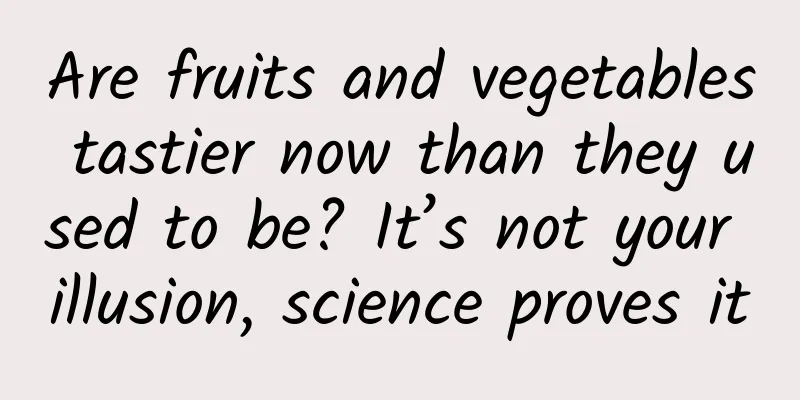Are fruits and vegetables tastier now than they used to be? It’s not your illusion, science proves it

|
When you look at the rows of brightly colored fruits and vegetables in the supermarket, you might not realize that the nutrient content of these crops has been declining over the past 70 years. Growing evidence from multiple scientific studies suggests that many fruits, vegetables, and grains grown today contain less protein, calcium, phosphorus, iron, vitamin B2, and vitamin C than they did decades ago. In an article published in the Journal of the American College of Nutrition in December 2004, scientists used nutrition data released by the U.S. Department of Agriculture between 1950 and 1999. Researchers at the University of Texas at Austin noticed that 13 nutrients in 43 different fruits and vegetables, such as asparagus, beans, strawberries and watermelon, had changed. Compared with the past, the protein, calcium, phosphorus, iron, vitamin B2 and ascorbic acid content of today's fruits and vegetables have all declined. Comparing the medians, the decline varies. For example, protein has decreased by 6%, and vitamin B2 has decreased by 38%, which is the largest decline. In particular, calcium levels dropped most significantly in broccoli, kale and mustard greens, while iron levels dropped significantly in beets, cucumbers and radishes, and vitamin C levels dropped significantly in asparagus, kale, mustard greens and radishes. Further research has since supported the idea that fruits and vegetables are less nutritious than in the past. A study published in the journal Foods in January 2022 found that while the iron content of most vegetables grown in Australia remained relatively similar between 1980 and 2010, the iron content of some vegetables had dropped significantly. Sweet corn, red potatoes, cauliflower, green beans, lima beans and chickpeas showed a 30 to 50 percent drop in iron content, while some fruits and vegetables showed an improvement, with Hass avocados, mushrooms and beets showing an increase in iron content. Not only fruits and vegetables, but also grains, the largest source of carbohydrates needed by our bodies, have also seen a significant decline in their nutritional content. A study published in Scientific Reports in 2020 found that the protein content in wheat fell by 23% from 1955 to 2016, and the content of manganese, iron, zinc and magnesium also dropped significantly. Various studies suggest that our grandparents ate healthier food than we do today. Moreover, nutrients are not only related to health, but also to flavor. For example, nutritious tomatoes are sweet and slightly acidic, and release aromatic flavors. The six major nutrients in them are richer than tomatoes that only have acidity or lack aromatic flavors. In addition, vegetables also show that delicious vegetables have more carbohydrates than "tasteless" vegetables. Therefore, it makes sense that the more nutritious vegetables and fruits are, the better they taste. So why are fruits and vegetables now less nutritious and less flavorful than in the past? The most critical point is that it is caused by modern farming methods. The authors of the first study mentioned above wrote their own speculation in the discussion that modern industry pays more attention to yield, and farmers are paid according to the weight of crops. Increasing yield per unit area means increasing planting density, so the nutrients of fruits and vegetables grown are diluted. Another reason is the reduction in fungal content in the soil. The growth of wheat, corn, rice, soybeans, potatoes, bananas, yams and flax is related to some key fungi, which can improve the ability of plants to obtain nutrients and water from the soil. The reduction of fungi is directly related to high-yield farming, so it is essentially related to farming patterns. Finally, rising greenhouse gas levels are also linked. All plants have a photosynthesis pathway, through which they absorb carbon dioxide from the atmosphere, break it down, and then use it to grow. However, when crops, including wheat, rice, barley, and potatoes, are exposed to higher levels of carbon dioxide, they produce more carbon-based compounds, resulting in a higher carbohydrate content. This leads to an imbalance, and fewer micronutrients are absorbed from the soil. Experiments described in a 2018 issue of the journal Science Advances confirmed that concentrations of protein, iron, zinc and several B vitamins decreased in 18 varieties of rice after exposure to higher levels of carbon dioxide. Of course, you don’t need to worry too much about the reduction in nutritional content. It’s just that the nutritional content of individual fruits and vegetables will be reduced. You can just eat a few more to offset that little nutritional loss. Let me end with a nutrition expert’s opinion: "It is not wise to keep complaining about the quality of food on the market. It is difficult for us to change the environment, but we can change our choices. We can learn to accept the slightly sour, astringent and bitter taste of natural fruits and vegetables, tolerate their not-so-glossy appearance, accept the natural change of turning black after being cut, accept fruits and vegetables with insects, accept fruit peels with blemishes and spots... If we are unwilling to accept all these, and always demand the sweetest, most fragrant, largest and most beautiful ones without insects, spots or defects, and also demand that the food be particularly natural and have a particularly high nutritional value, then we are a bit like Ye Gong who loves dragons too much." Cover source: wordpress References: https://pubmed.ncbi.nlm.nih.gov/15637215/https://www.ncbi.nlm.nih.gov/pmc/articles/PMC8750575/https://www.nature.com/articles/s41598-020-78504-x#Tab3 |
<<: “Severe cold + dark night”, how to make astronauts feel the warmth of returning home?
>>: How to recover to full health after post-holiday syndrome?
Recommend
Explore NVIDIA's leadership in China's high-end ADAS sector
Recently, NVIDIA was ranked the champion of Canal...
Understand the four key points of professional trader training: analysis of main force behavior!
Understand the four key points of professional tr...
The reason why the great poet Han Yu burst into tears was...丨Science Museum
Ancient scholars advocated "reading thousand...
Cultivate the blue land! Use the "materials" of a great country to support the "deep blue dream" of the ocean
Produced by: Science Popularization China Author:...
Dongfeng Fengguang 580 Smart Link model debuts at Guangzhou Auto Show: Would you buy a talking domestic SUV?
Judging from the domestic SUV sales ranking for O...
How to cook dog meat?
Dog meat contains a large amount of protein, and ...
He may be the world's first Apple iPhone 6s user
Thanks to the International Date Line, the first ...
Gaia-0 Basic Beginner Short Video Monetization Training Camp
Gaia-0 Basics Novice Short Video Monetization Tra...
8 combinations of targeted information flow promotion methods, available for testing!
Many people don’t know how to set up the targetin...
How do you pronounce these common bronze wares, such as yan, fu, jia, yi, hu, lei, you?
Bronze ware is the witness and carrier of the ori...
What the hell is this? How to choose the online promotion method?
Recently, many companies may be promoting the &qu...
World Bicycle Day | Cycling regularly has so many benefits! But...
Today is World Bicycle Day . Cycling is a healthy...
Inventory of 2021 brand Christmas advertisements!
It’s December in the blink of an eye, and it’s on...
Internet promotion must start with understanding users!
2016 was also a year of rapid development of the I...
Foreign media: Huawei is preparing to release its own mobile operating system
For Huawei, Google's move means that they can...









